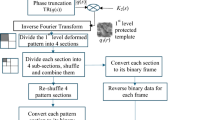Abstract
Biometric bits extraction has emerged as an essential technique for the study of biometric template protection as well as biometric cryptosystems. In this paper, we present a non-invertible but revocable bits extraction technique by means of quantizing the facial data from two feature extractors in the phase domain, which we coin as aligned feature-level fusion phase quantization (AFPQ). In this technique, we utilize helper data to achieve the revocability requirement of bits extraction. The feature averaging and remainder normalization technique are integrated with the helper data to reduce feature variance within the same individual and increase the distinctiveness of bit strings of different individuals to achieve good recognition performance. A scenario in which the system is compromised by an adversary is also considered. As a generic technique, AFPQ can be easily extended to multiple different biometric modalities.
Similar content being viewed by others
References
Bartlett, M. S., Movellan, J. R., & Sejnowski, T. J. (2002). Face recognition by independent component analysis. IEEE Transactions on Neural Networks, 13(6), 1450–1464.
Buciu, I., & Pitas, I. (2008). Understanding complex systems. In Organic computing (pp. 303–320). Berlin: Springer. ISBN 978-3-540-77656-7.
Burton, A. M., Jenkins, R., Hancock, P. J. B., & White, D. (2005). Robust representations for face recognition: the power of averages. Cognitive Psychology, 51(3), 256–284.
Chang, Y.-J., Zhang, W., & Chen, T. (2004). Biometrics-based cryptographic key generation. In IEEE international conference on multimedia and expo, 2004. ICME 2004 (Vol. 3, pp. 2203–2206).
Chen, C., Veldhuis, R. N. J., Kevenaar, T. A. M., & Akkermans, A. H. M. (2007). Multi-bits biometric string generation based on the likelihood ratio. In First IEEE international conference on biometrics: theory, applications, and systems, BTAS.
Chen, B., & Wornell, G. W. (2001). Quantization index modulation: a class of provably good methods for digital watermarking and information embedding. IEEE Transactions on Information Theory, 47(4), 1423–1443.
Daugman, J. (2006). Probing the uniqueness and randomness of IrisCodes: results from 200 billion Iris pair comparisons. Proceedings of the IEEE, 94(11), 1927–1935.
Georghiades, A. S., Belhumeur, P. N., & Kriegman, D. J. (2001). From few to many: illumination cone models for face recognition under variable lighting and pose. IEEE Transactions on Pattern Analysis and Machine Intelligence, 23(6), 643–660. http://vision.ucsd.edu/~leekc/ExtYaleDatabase/ExtYaleB.html.
Golic, J. D., & Baltatu, M. (2008). Entropy analysis and new constructions of biometric key generation systems. IEEE Transactions on Information Theory, 54(5), 2026–2040.
Han, Q., Wang, Z., & Xiamu, N. (2006). A non-uniform quantizing approach to protect biometric templates. In International conference on intelligent information hiding and multimedia signal processing, IIH-MSP ’06 (pp. 693–698).
Jenkins, R., & Burton, A. M. (2008). 100% accuracy in automatic face recognition. Science, 319(5862), 435.
Kong, B., Cheung, K., Zhang, D., Kamel, M., & You, J. (2006). An analysis of biohashing and its variants. Pattern Recognition, 39(7), 1359–1368.
Lee, K. C., Ho, J., & Kriegman, D. (2005). Acquiring linear subspaces for face recognition under variable lighting. IEEE Transactions on Pattern Analysis and Machine Intelligence, 27(5), 684–698.
Lee, D. D., & Seung, H. S. (1999). Learning the parts of objects by non-negative matrix factorization. Nature, 401, 788–791.
Linnartz, J.-P., & Tuyls, P. (2003). New shielding functions to enhance privacy and prevent misuse of biometric templates. In AVBPA (pp. 393–402).
Lumini, A., & Nanni, L. (2007). An improved BioHashing for human authentication. Pattern Recognition, 40(3), 1057–1065.
Maio, D., & Nanni, L. (2004). Multihashing, human authentication featuring biometrics data and tokenized random number: A case study. In FVC2004.
Nanni, L., & Lumini, A. (2008). Local binary patterns for a hybrid fingerprint matcher. Pattern Recognition, 41(11), 3461–3466.
Ratha, N., Connell, J., & Bolle, R. (2001). Enhancing security and privacy in biometrics-based authentication systems. IBM Systems Journal, 40(3), 614–634.
Schneier, B. (1999). Inside risks: the uses and abuses of biometrics. Communications of the ACM, 42(8), 136.
Sim, T., Baker, S., & Bsat, M. (2003). The CMU pose, illumination, and expression database. IEEE Transactions on Pattern Analysis and Machine Intelligence, 25(12), 1615–1618.
Teoh, A. B. J., Connie, T., Ngo, D., & Ling, C. (2006). Remarks on BioHash and its mathematical foundation. Information Processing Letters, 100(4), 145–150.
Teoh, A. B. J., Goh, A., Ngo, D.. & Ling, C.. (2006). Random multispace quantisation as an analytic mechanism for biohashing of biometric and random identity inputs. IEEE Transactions on Pattern Analysis and Machine Intelligence, 28(12), 1892–1901.
Teoh, A. B. J., Kuan, Y. W., & Lee, S. (2008). Cancellable biometrics and annotations on BioHash. Pattern Recognition, 41(6), 2034–2044.
Teoh, A., Ngo, D., & Goh, A. (2004). Biohashing: two factor authentication featuring fingerprint data and tokenised random number. Pattern Recognition, 37(11), 2245–2255.
Teoh, A. B. J., & Toh, K.-A. (2008). Secure biometric-key generation with biometric helper. In The 3rd IEEE conference on industrial electronics and applications (ICIEA 2008) (pp. 2145–2150).
Turk, M. A., & Pentland, A. P. (1991). Eigenfaces for recognition. Cognitive Neuroscience, 3(1), 71–86.
Tuyls, P., Akkermans, A. H. M., Kevenaar, T. A. M., Schrijen, G. J., Bazen, A. M., & Veldhuis, R. N. J. (2005). Practical biometric authentication with template protection. In International conference on audio- and video-based biometric person authentication, AVBPA (Vol. 3546, pp. 436–446).
Uludag, U., Pankanti, S., Prabhakar, S., & Jain, A. K. (2004). Biometric cryptosystems: issues and challenges. Proceedings of the IEEE, 92(6), 948–960.
Vielhauer, C., & Steinmetz, R. (2004). Handwriting: feature correlation analysis for biometric hashes. EURASIP Journal on Applied Signal Processing, 2004(4), 542–558. Special issue on Biometric Signal Processing.
Yip, W. K., Teoh, A. B. J., & Ngo, D. C. L. (2007). Secure hashing of dynamic hand signatures using wavelet-Fourier compression with BioPhasor mixing and 2N discretization. EURASIP Journal on Advances in Signal Processing, 2007, 59125. 8 pages.
Author information
Authors and Affiliations
Corresponding author
Rights and permissions
About this article
Cite this article
Lee, H., Teoh, A.B.J. & Kim, J. Biometric bits extraction through phase quantization based on feature level fusion. Telecommun Syst 47, 255–273 (2011). https://doi.org/10.1007/s11235-010-9317-z
Published:
Issue Date:
DOI: https://doi.org/10.1007/s11235-010-9317-z




